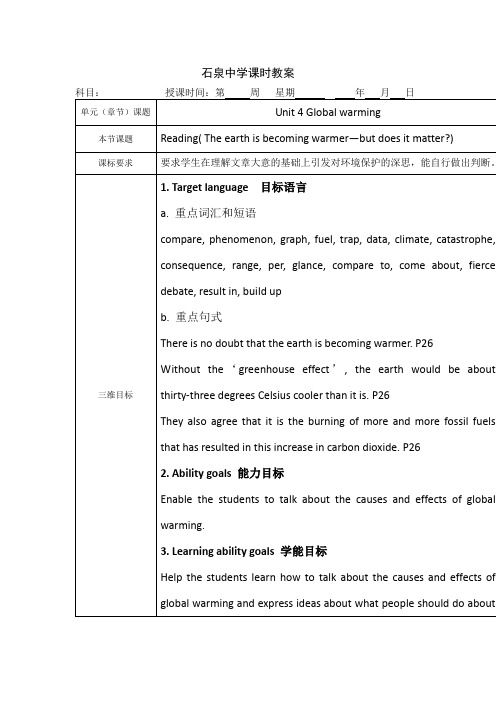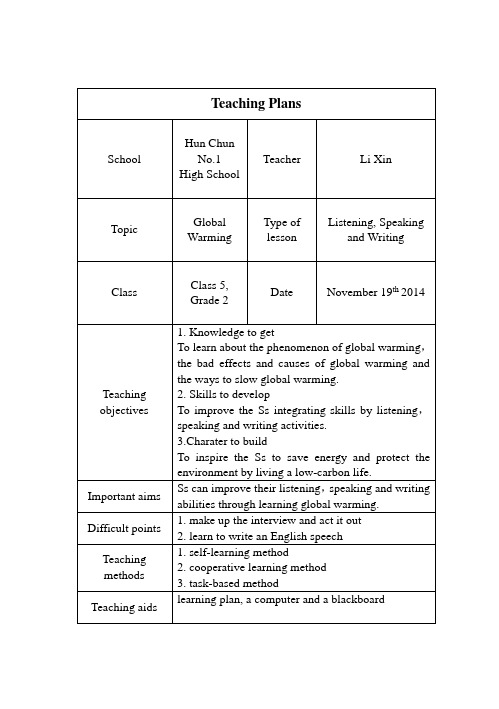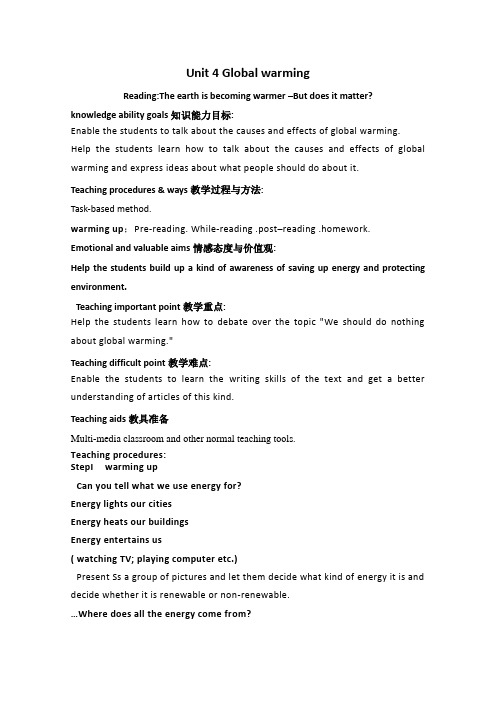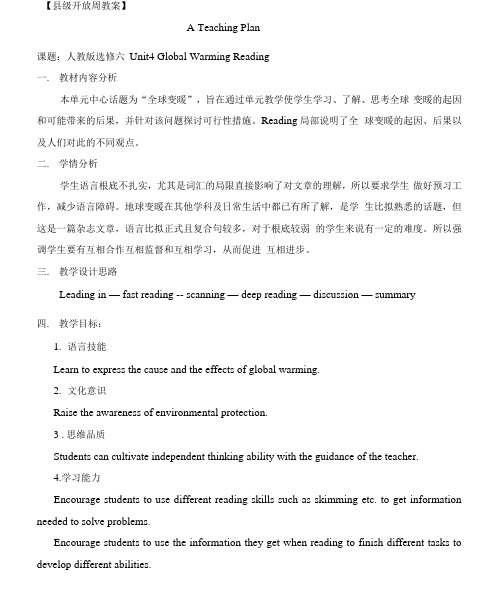秋季课程人教版高二英语选修六unit4 Global warming 教案
人教版高二英语选修6教案:Unit4+Global+warming+period2.doc

石泉中学课时教案精美句子1、善思则能“从无字句处读书”。
读沙漠,读出了它坦荡豪放的胸怀;读太阳,读出了它普照万物的无私;读春雨,读出了它润物无声的柔情。
读大海,读出了它气势磅礴的豪情。
读石灰,读出了它粉身碎骨不变色的清白。
2、幸福幸福是“临行密密缝,意恐迟迟归”的牵挂;幸福是“春种一粒粟,秋收千颗子”的收获. 幸福是“采菊东篱下,悠然见南山”的闲适;幸福是“奇闻共欣赏,疑义相与析”的愉悦。
幸福是“随风潜入夜,润物细无声”的奉献;幸福是“夜来风雨声,花落知多少”的恬淡。
幸福是“零落成泥碾作尘,只有香如故”的圣洁。
幸福是“壮志饥餐胡虏肉,笑谈渴饮匈奴血”的豪壮。
幸福是“先天下之忧而忧,后天下之乐而乐”的胸怀。
幸福是“人生自古谁无死,留取丹心照汗青”的气节。
3、大自然的语言丰富多彩:从秋叶的飘零中,我们读出了季节的变换;从归雁的行列中,我读出了集体的力量;从冰雪的消融中,我们读出了春天的脚步;从穿石的滴水中,我们读出了坚持的可贵;从蜂蜜的浓香中,我们读出了勤劳的甜美。
4、成功与失败种子,如果害怕埋没,那它永远不能发芽。
鲜花,如果害怕凋谢,那它永远不能开放。
矿石,如果害怕焚烧(熔炉),那它永远不能成钢(炼成金子)。
蜡烛,如果害怕熄灭(燃烧),那它永远不能发光。
航船,如果害怕风浪,那它永远不能到达彼岸。
5、墙角的花,当你孤芳自赏时,天地便小了。
井底的蛙,当你自我欢唱时,视野便窄了。
笼中的鸟,当你安于供养时,自由便没了。
山中的石!当你背靠群峰时,意志就坚了。
水中的萍!当你随波逐流后,根基就没了。
空中的鸟!当你展翅蓝天中,宇宙就大了。
空中的雁!当你离开队伍时,危险就大了。
地下的煤!你燃烧自己后,贡献就大了6、朋友是什么?朋友是快乐日子里的一把吉它,尽情地为你弹奏生活的愉悦;朋友是忧伤日子里的一股春风,轻轻地为你拂去心中的愁云。
朋友是成功道路上的一位良师,热情的将你引向阳光的地带;朋友是失败苦闷中的一盏明灯,默默地为你驱赶心灵的阴霾。
高二英语选修六 Unit 4 Global warming教案

教案1 Unit 4 Global warmingWarming up & ListeningTeaching goalsEnable the students to know something about energy resources and something that use energy, and listen for details and catch the specific information as much as possible. Learning ability goalsEnable the students to predict some important information in the process of listening and encourage the students to talk about the situations according to the listening materials.Teaching important and difficult pointsHow to make sure the answers of listening material.Teaching aidsA recorder and cassette tapes, a projector, and a computerTeaching proceduresStep 1 Warming upDo you know any kind of energy resource?Do you know anything that use energy?things that use energy in a housele ornot.(Slide show: pictures of some forms of energy)wind energy renewablesolar energy renewablehydroelectric power renewablegeothermal energy renewabletidal energy renewablebiomass energy renewablenuclear power plant, non-renewable (picture)an oil refinery(精炼厂), non-renewable (picture)coal power station, non-renewable (picture)natural gas non-renewable (picture)uranium Ore (铀矿石) non-renewable (picture)The element uranium does not occur in pure form in nature but is found in m inerals such as carnotite(钒钾铀矿), pictured above. (picture)Conclusionnon-renewablecoal oil natural gas Uranium fossil fuelsrenewablewind (wind power) sun (solar energy) water (hydro-electric power)plant waste (biomass energy) hot springs or geysers (geothermal energy)the sea (tidal energy)Slide showWhat are fossil fuels?Ancient animal and plant material below the surface of the earth with a high carbon content, such as coal, oil and natural gas, which can be burnt to produ ce energy.Also known as non-renewable energy because once they are used they have go neforever; they cannot be renewed.Step 2 Pre-listeningRead Exercise 1 together:1. Read the statements below and tick the ones you agree with.2. Listen to the tape and answer and decide which statement Professor Chen d oesNOT agree with.1. We'll have to stop using fossil fuels.2. About 90% of the world's energy comes from fossil fuels.3. We can replace fossil fuels with renewable sources of energy.4. Nuclear power is a good source of energy.5. In the future, we'll need new technologies to replace fossil fuels.6. It's the developed countries who are to blame for producing most of the car bondioxide.3. Listen again and tick the phrases that Professor Chen uses to agree or disag reewith Li Bin.Slide showExactly. I’m afraid I di sagree with you.That’s true. I’m afraid not.That’s right. I don’t think so.That’s correct. No way.I agree. I don’t agree.4. Listen for the third time and fill in the blanks.1.Our modern _________ societies depend on the energy we get from___ ______.2.It’s a very ____________ and cheap form of energy.3.Can’t we just ________ fossil fuels with ________ sources of energy li ke sun or wind power?4.However, whatever we do, we have to do it as a ________________.5.The _________ countries are really the ones to ______.Keys:1.industrial; fossil fuels 2. concentrated 3。
高中英语(人教版)选修六 Unit 4 Global warming-Reading 教案

Unit4. The Earth Is Becoming Warmer-But Does it Matter 教案Teaching Aims:1.Improve the students’ reading ability2.Having concept of “greenhouse gases”,”greenhouse effect””global warming”3.Know scientists’ attitude towards “global warming”4.Can write down the advantages as well as disadvantages of “global warming” and can express them to the whole classTeaching Important and Difficult Points:1.How to Improve the students’ reading ability2.How to guide students to write and to express his or her attitude in own wordsEmotional Aims:Enable the students to know the importance of protecting earthMedia preparation:Blackboards, PPT, video player, Mp3 playerTeaching Process:Step1. GreetingsGreet the whole classStep2. Lead-inShow three groups of pictures, which are about shallow understanding of “global warming”, and let them choose the right picture of each group.eg.Which of the following picture doesn’t show the phenomenon?Step3. Fast-ReadingMatch: the main idea of each paragraph. (Divided them into seven groups,each group answer one paragraph.)Step4. Intensive Reading1)Analyze paragraph1 and paragraph2 in a way of graph1. Answer two questions.What is this graph about? What has caused this phenomenon?2) Listen to paragraph3 and then discuss questions in group to choose right answer.Greenhouse gases refer to ____.A. carbon dioxideB. the burning of fossil fuelsC. byproducts of the burning of fossil fuelsD. coal, natural gas and oilGreenhouse effect ____.A. is a natural phenomenonB. happens when there’s too much carbon dioxideC. does great harm to human beingsD. makes life for human beings betterSummarize this paragraph in a way of simple drawing.3)Give a graph2, ask one student to analyze the graph2 as the way of graph1. Then combined with Paragraph4 and Paragraph5, judge T or F. The carbon dioxide content in the air increased by 70 parts per million from 1957 to 1997.All scientists accept the data in graph 2 except Charles Keeling.4)Read paragraph6 together and summarize the different attitudes towards global warming.Dr.Foster: It would lead to a catastrophe.George Hambly: We should not worry about it.5)Read paragraph7 independently and answer questions.If we start reducing the amount of carbon dioxide and other greenhouse gases, is the climate going to stop?What's the attitude of the author? Positive?Negative or Neutral?6)Summarize the structure of the whole passagePart1 (paragraph1)Part2 (Paragraph2-5)Part3 (Paragraph6)Part4 (Paragraph7)Step 5 WritingWrite down the advantage or disadvantage of global warming in your opinion.Step 6 Play a video to express my view.Step7 HomeworkSurf the Internet for more informationabout global warming.Teaching ReflectGlobal Warming is one of the most important topic we face in this century. Teacher should guide students to focus this topic and do activities to protect our earth.。
人教版英语选修六Unit 4 Global Warming(Listening, Speaking and Writing)教案

Teaching methods
1.self-learningmethod
2.cooperativelearningmethod
3.task-basedmethod
Teaching aids
learningplan, a computer and a blackboard
Teaching objectives
1. Knowledge to get
To learn about the phenomenon of global warming,the bad effects and causes of global warming andtheways to slow global warming.
Givethem the key words and phrases,help them finish the task and make a comment
Create situations to improve the Ss’speaking ability
11’
Step 5
Writing training
Teaching procedures
Teaching tasks
Students’activities
Teachers’activities
Purposes
Time
Step 1 Lead in
Watch the video and answer two questions.
Play the video and ask two questions
Lead into the topic
人教版英语选修六Unit 4 Global Warming(Using Language:Reading and writing)教案

兰州市骨干教师评选教案时间:4月15日地点:兰州新区永登五中高二(4)教室授课教师:桑越茂科目:英语教材:人教版高中英语选修六授课课题:UNIT 4 Using language: Reading and Writing教材分析:1、本单元中心话题是Global warming ,旨在通过本单元教学使学生经过学习认识到全球变暖的起因和它所带来的种种后果,让学生进一步了解地球面临的其它严重问题,帮助学生的树立“节约能源,保护环境”的环保意识,引导学生运用所学语言、句式表达自己对这些现象的看法,培养学生用英语表达自己观点的能力。
2、Reading and Writing部分通过读者和杂志社之间的两封信件,使学生更多地了解作为“地球村”的一员,如何为控制全球变暖做出自己应有的努力。
通过make a poster,write a short passage等不同活动的参与,帮助学生更多地联系自己的生活习惯,树立从自身做起践行环保的观念,这样使课堂的抽象知识变为了社会实践,实现了真正意义上的学以致用。
学情分析:本次教学的实施对象是高二(4)班。
由于学生英语水平参差不齐,学生英语基础薄弱,学生学习英语的困难很大,本节课的教学可以说是一个不小的挑战。
教学理念:坚持“教师为主导,学生为主体,任务为导向”的教学理念;坚持贯彻“教中学,学中用”的实用主义教学理念。
教学方法:学导性教学模式与任务型教学法相结合(基本环节:任务引领——小组合作--交流展示-评价总结)教学目标:1. 知识和技能目标1)知识目标A. 重点词汇和短语: electrical, motor, can (n.), microwave, disagreement, heading, make a difference, put up with, leave an electrical appliance on, so long as等。
B. 重点句式:Together, individuals can make a difference.It takes a lot of energy to make things from new materials. Remember -- your contribution counts‘C.通过学习,让学生更多了解全球变暖现象及成因,以及阻止全球变暖的具体做法。
Unit4《GlobalWarming》教案6(人教版选修6)

Unit 4 Global warmingReading:The earth is becoming warmer –But does it matter? knowledge ability goals知识能力目标:Enable the students to talk about the causes and effects of global warming. Help the students learn how to talk about the causes and effects of global warming and express ideas about what people should do about it.Teaching procedures & ways教学过程与方法:Task-based method.warming up;Pre-reading. While-reading .post–reading .homework. Emotional and valuable aims情感态度与价值观:Help the students build up a kind of awareness of saving up energy and protecting environment.Teaching important point教学重点:Help the students learn how to debate over the topic "We should do nothing about global warming."Teaching difficult point教学难点:Enable the students to learn the writing skills of the text and get a better understanding of articles of this kind.Teaching aids教具准备Multi-media classroom and other normal teaching tools.Teaching procedures:StepI warming upCan you tell what we use energy for?Energy lights our citiesEnergy heats our buildingsEnergy entertains us( watching TV; playing computer etc.)Present Ss a group of pictures and let them decide what kind of energy it is and decide whether it is renewable or non-renewable.…Where does all the energy come fr om?Picture1 Wind millsPicture2 : a coal power stationPicture3:an oil refinery Picture4:a nuclear power plant Picture5:Solar panels Picture6: a hydro damStep II Pre-reading ;1. Show a picture of greenhouse on the screen, and ask1. What is it in the picture?It ’s a greenhouse made of glass.2. What is it used for?It ’s used for growing plants, especially during cold weather.3. How does it work?The air inside is warm because the glass traps the heat from the sun and keeps it from escaping. This makes the greenhouse heat up and so the plants can grow throughout the cold period.4. What is greenhouse gases?The gases surrounding the earth,including carbon dioxide, methane and water vapor.5. What do you think greenhouse gases do?They trap heat from the sun and therefore warm the earth.Step III While- readingTask 1: skimmingGlance quickly at the magazine article and answer the questions.1. Who wrote the magazine article? What is the name of the magazine?Sophie Armstrong wrote the magazine article. The name of the magazine is Earth Care.2. What are the names of the three scientists mentioned in the article?They are Dr. Janice Foster, Charles Keeling and George Hambley.3…. What is the main topic of the article?Global warming/ the warming of the earth.Task 2:listen andScan the textRead it quickly and try to get the general idea and divide the whole passage into several parts and summarize the main idea.False: 1, 2, 4, 9, 10Correct sentences:1. The temperature last century increased much.2. Not everyone believes that global warming is caused by human activities. 4. Natural gas is not a greenhouse gas but a fossil fuel.9. George Hambley thinks that more carbon dioxide is a positive thing and it will make plants grow faster.10. It is unknown what the effects of global warming will be.Task 3: Group activity .Should we do nothing about global warming?StepⅣPost-reading:1.write a summary.Do not include your own opinion, but be sure to use our own words (about 30words.)(不能添加自己的见解,但是要用自己的语言概括.大约30个词左右)The reading passage is a discussion and puts forward different points of view about the effect of increased carbon dioxide in the atmosphere the causes of theearth’s increased temperature and the possible effects .Ste pIIV.HomeworkRead the passage again and review the new words and expressions.。
【教案】人教版选修六Unit4 Global Warming Reading

【县级开放周教案】A Teaching Plan课题:人教版选修六Unit4 Global Warming Reading一. 教材内容分析本单元中心话题为“全球变暖”,旨在通过单元教学使学生学习、了解、思考全球变暖的起因和可能带来的后果,并针对该问题探讨可行性措施。
Reading局部说明了全球变暖的起因、后果以及人们对此的不同观点。
二. 学情分析学生语言根底不扎实,尤其是词汇的局限直接影响了对文章的理解,所以要求学生做好预习工作,减少语言障碍。
地球变暖在其他学科及日常生活中都已有所了解,是学生比拟熟悉的话题,但这是一篇杂志文章,语言比拟正式且复合句较多,对于根底较弱的学生来说有一定的难度。
所以强调学生要有互相合作互相监督和互相学习,从而促进互相进步。
三. 教学设计思路Leading in — fast reading -- scanning — deep reading — discussion — summary四. 教学目标:1.语言技能Learn to express the cause and the effects of global warming.2.文化意识Raise the awareness of environmental protection.3 .思维品质Students can cultivate independent thinking ability with the guidance of the teacher.4.学习能力Encourage students to use different reading skills such as skimming etc. to get information needed to solve problems.Encourage students to use the information they get when reading to finish different tasks to develop different abilities.五. 教学重难点重点Help the students learn the cause and effects of global warming.难点How to guide the students to understand global warming better and collect specific details to voice their own views in a critical way.六. 教学方法Task-based Language Teaching Approach七. 教学策略充分利用多媒体辅助教学,发挥信息技术的作用,丰富教学内容,提高学生的学习兴趣和课堂教学效率。
人教版高中英语选修6精选教案:Unit4GlobalwarmingReading

⼈教版⾼中英语选修6精选教案:Unit4GlobalwarmingReading⼈教版选修6 Unit 4 Global warming教案ReadingTeaching goalsTarget languagewords and phrases:energy, light(v.), heat(v.), renewable, non-renewable, run out, compare, phenomenon, graph, fuel, trap, data, climate, catastrophe, consequence, range, per, glance, compare to, come about, fierce debate, result in, build up, keep onAbility goalsEnable the students to talk about different sources of energy.Enable the students to read the text, understand what it is about and talk about the causes and effects of global warming. Teaching important & difficult pointsEnable the students to get a better understanding of articles of this kind.Teaching aidsA projector and a blackboardTeaching proceduresStep 1 Warming upT:Now let's look at a picture on the slide and answer the question below.What is the greenhouse made and used for?A greenhouse is made of glass and is used for growing plants, especially during cold weather. What's greenhouse effect? Step 2 ScanningRead the text quickly and find the answer to the questions:1. Who wrote the magazine article? What is the name of the magazine?Sophie Armstrong, Earth Care.2. What are the names of the three scientists mentioned in the article?Dr Janice Foster, Charles Keeling, George Hambley.3. What do they think about global warming? Do they agree with one another?They don't agree with each other.Dr. Janice Foster thinks the effects of global warming could be very serious.George Hambley thinks global warming will be mild with few bad environmental consequences.Charles Keeling believes it is the burning of more and more fossil fuels that is resulting in a big increase in carbon dioxide. The first graph shows the temperature increase of one degree Fahrenheit between 1860to 2000. The second graph shows the carbon dioxide content in the atmosphere from 1957 to 1977.4. What are the two graphs about?The first graph shows the temperature increase of one degree Fahrenheit between 1860to 2000. The second graph shows the carbon dioxide content in the atmosphere from 1957 to 1977.5. What is the main topic of the article?Global warming/ the warming of the earth.Step 3 SkimmingRead the passage carefully and judge whether the statements are true or false.1. The temperature last century didn't increase much.2. Everyone believes that global warming is caused by the activities of humans.3. Janice Foster believes that global warming is caused b the burning fossil fuels.4. Natural gas is a greenhouse gas.5. Carbon dioxide is a byproduct of burning fossil fuels.6. People accept Charles Keeling's data because he took accurate measurements.7. Flooding could be one of the effects of future global warming.8. George Hambley believes scientists are just guessing about the effects of globalwarming.9. George Hambley is worried about the effects of carbon dioxide on plant growth.10. It is clear what the effects of global warming will be.Keys: True: 3, 5, 6, 7, and 8 False: 1, 2, 4, 9, 10Step 4 Detailed readingRead the text carefully and try to find out how many parts we can divide the text into and find out the main idea of each part. Part (Para_ to Para_ )Main ideaPart 1 (Para _1_)introduce a debate over the issue of global warmingPart 2 (Para _2__ to _4__)illustrate how global warming comes aboutPart 3 (Para _5__ to 10___)list two different attitudes among scientists towards global warmingPart 4 (Para _11__ to ___)It's up to readers to think and decide whether people should do something about global warming or not.Step 5 DebateGet into groups of six. Decide which three in your group are going to agree with the statement and which three are going to disagree with the statement.Group A: We shall do something about global warming.Group B: We shall do nothing about global warming.Group A discuss why they agree with the statement; Group B discuss why they disagree.Group A and B get together. Tell each other the reasons why agree or disagree with the statement. Step 6 Homework1. Read the passage again and review the new words and expressions.2. Prepare the debate in groups.3. Surf the Internet for more information about global warming。
- 1、下载文档前请自行甄别文档内容的完整性,平台不提供额外的编辑、内容补充、找答案等附加服务。
- 2、"仅部分预览"的文档,不可在线预览部分如存在完整性等问题,可反馈申请退款(可完整预览的文档不适用该条件!)。
- 3、如文档侵犯您的权益,请联系客服反馈,我们会尽快为您处理(人工客服工作时间:9:00-18:30)。
above/below average高于/低于平均水平
on (the/an) average平均地||;通常||;按平均值
Take the average of those ratios and multiply by a hundred.
算出那些比率的平均值再乘以100。
她做过许多不同的工作||,从厨师到游平均的||;普通的(normal)||;典型的(typical)||;n.平均数||;平均水平||;v.平均为||;计算出……的平均数(be equal to...as an average
an average of...……的平均数
去年春天||,由于疏忽大意造成了工程的坍塌。
That came about when we went to Glastonbury last year.
那是我们去年去格拉斯顿伯里的时候发生的事。
特别提醒
come about相当于happen或occur||,均无被动形式。
2
subscribe for sth.认购……
Quantities of food and tents were sent to Ya’ an from Shandong.
大量的食品和帐篷从山东运到了雅安。
My brother bought a large quantity of books.
我弟弟买了大量的书。
2
tend to do...倾向于做……||;往往会……
tend sb.照顾某人
have a tendency to do sth.有做某事的倾向
The nurse skillfully tended soldiers’ wounds.
护士熟练地护理着那些士兵的伤口。
3
oppose A against/to B使A与B相对抗
oppose doing sth.反对做某事
2)、一般疑问句的强调句型:______________________________________
3)、特殊疑问句的强调句型:_______________________________________
1
in quantity大量
quantities of+名词+复数谓语动词许多……
a quantity of+复数名词+复数谓语动词/+不可数名词+单数谓语动词大量……
4
It is stated that...据称……
as stated above如上所述
in a...state处于……状态
make a statement陈述||;发表声明
For the first few months after Daniel died||,I was in a state of clinical depression.
How does it come about that...?……是怎样发生的?
come across偶遇||;被理解
when it comes to...当谈到……
come up with想出(主意)||;找到(答案)
As a result of carelessness||,the project collapse came about in the last spring.
it的用法(2)
It用于强调句型中
1.It is/was+被强调部分+that/who+其他||,这个句型可以强调主语、宾语、介词短语及状语。
I met Tom in the park yesterday.
→It wasin the parkthatI met Tom yesterday.
2.强调句的特殊疑问句句型为:特殊疑问词+is/was it that/who+陈述句
口语中相当于“Don't worry.”或“Don't hurry.”||,用来劝告别人||,表示“不要慌、沉住气、别担心”。2·1·c·n·j·y
Take it easy!He will do it well!
3.It all depends./That all depends.
口语中相当于“It hasn't been decided yet.”表示“那得看情况||,还未定下来。”中/华-21世纪1
复习预习:
1、上节课作业订正。
2、it可以帮助构成强调句
1)、陈述句的强调句型:______________________________________________
需要注意的地方:
* It在这一结构中作主句的主语||,所以即使被强调部分是复数名词||,也要用___或____
*如果被强调部分是时间、地点、方式或原因依然用_____||;强调人时可以用____或__
4.It is/was not until+被强调部分+that...
I didn't realize she was a famous film star until she took off her dark glasses.
→It was not untilshe took off her glassesthatI realized she was a famous film star.
What did you want to find yesterday?
→Whatwas it thatyouwantedto find yesterday?
3.强调句与名词性从句的结合
I want to know what you wanted to find yesterday.
→I want to know whatit was thatyou wanted to find yesterday.
within/in the range of在……范围之内range from...to...从……到……之间变化
range between...and...在……到……之间变动
A wide range of colors and patterns are available.各种颜色和样式都有。
She has had a number of different jobs||,ranging from chef to swimming instructor.
be opposed to反对
as opposed to与……相对照||;而非
The king couldn’t bear anyone to oppose him.
国王不能忍受任何人反抗他。
The father is opposed to his son’s marriage.
爸爸反对儿子的婚事。
2. exist v.存在
existence n.存在
3.state v.陈述||,说明
statement n.声明||,阐述
4. environment n.环境
environmental adj.周围的||,环境的
environmentalist n.环境保护主义者
1
It comes about that...……发生。
American shares rose||,on average||,by 38%.
美国股票价格平均上涨了38%。
7
It is advocated that...主张||,提倡……
advocate doing...主张做……
an advocate of/for支持……的人
He was a strong advocate of free market policies and the multiparty system.
您拨打的用户已关机。
3
I’m calling on behalf of Mr. Black.
我是代布莱克先生打电话来的。
I apologize to you on behalf of the hotel.
我谨代表旅馆向你们道歉。
It is OK to leave an electrical appliance on so long as you are using it—if not||,turn it off!只要你在使用电器设备||,你便可以把它开着。如果不用就把它关掉!
适用学科
高中英语
适用年级
高二
适用区域
人教新课标版
课时时长(分钟)
2课时
知识点
1单词学习及辨析
2“it”的用法(2)
3句型学习
教学目标
1.掌握本单元重点词汇的基本含义与用法||;
2.锻炼提升写作能力。
教学重点
1.重点的词汇与句型||;
2.书面表达的书写思路。
教学难点
如何准确地运用重要词汇和句型进行表达
在当时那种一触即发的形势下||,采取那样的策略太危险了。
I wish we could have met under happier circumstances.
我真希望我们是在更愉快的情况下相识的。
本单元单词词性变化归纳
1.agree v.同意
disagree v.不同意
agreement/disagreement n.同意/不同意
丹尼尔去世后的最初几个月里||,我一直处于临床抑郁症的状态。
He stated that he knew nothing about the accident.
他声称对那起事故一无所知。
5 range n.批||;组||;范围||;山脉||;v.变动||,变化||;排列||;涉及
beyond/out of one’s range/the range of sb.超出某人的范围
-It's up to you.
